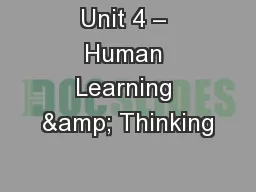

Psychology 11 Having completed this unit you will be able to Explain the roles of classical and operant conditioning in learning Understand the relationship between spirant conditioning and punishment ID: 560952
Download Presentation The PPT/PDF document "Unit 4 – Human Learning & Thinking" is the property of its rightful owner. Permission is granted to download and print the materials on this web site for personal, non-commercial use only, and to display it on your personal computer provided you do not modify the materials and that you retain all copyright notices contained in the materials. By downloading content from our website, you accept the terms of this agreement.
Slide1
Unit 4 – Human Learning & Thinking
Psychology 11
Having completed this unit you will be able to:Explain the roles of classical and operant conditioning in learning.Understand the relationship between spirant conditioning and punishment.Understand the relationship between operant conditioning and programmed learning.Understand the relationship between operant conditioning and biofeedback..Describe the cognitive approach to learning.Identify some factors that may positively affect your ability to learn more.Discuss how memory works and why people forget thingsGive a definition of thinking; discuss creative thinking, imagination, and problem solving.
Ch
9 – Principles of Learning
Ch
10 – Learning, Remembering, & Forgetting
Ch
11 – The Process of ThinkingSlide2
Chapter 9 – Principles of Learning
This Chapter Presents:The roles of classical and operant conditioning in learning
The relationship between operant conditioning and punishment, programmed learning, and biofeedbackThe cognitive approach to learningBefore we begin… what is learning?Definition: Learning refers to lasting changes in behaviour that occur as a result of practice or other past experiences – it usually involves doing something that you haven’t done before…Slide3
Tell me more about this “learning”…
While learning may involve doing something that you haven’t done before, it also may
involve doing something that you have done before, but are now doing it in a different way… Some examples of learning includes:Acquiring and making use of facts (essays & reports)Acquiring and using certain skills (riding a bike & looking both ways when you cross the street)*Not all behaviour has to be learned…i.e. blinking your eyes when dust gets in them – this is more of a reflex action; it does not involve previous experience or practiceSlide4
More of this “Unlearned” Behaviour…
As we have mentioned, as we develop, certain “changes” occur…i.e. crawling as a baby – is this learned or unlearned?While we say “the baby has learned to crawl” truthfully, what has happened is that the baby’s muscles & nerves have developed enough to
allow for crawlingThe goal of this chapter is to describe the “changes in behaviour that are not the result of reflexes and are not primarily due to physical growth.”Slide5
First on the list of Learnt Behaviour: Classical Conditioning
A famous example of Classical Conditioning involves this well-documented scenario…Ivan Pavlov, a Russian scientist, observed mouth-watering behaviour when he fed dogs in his laboratory
He decided to set up an experiment in which the mouth watering could be replicated by ringing a bell that was associated with meat powder (mmm mmm good)This was a controlled experiment, the dog could not see Pavlov…Looked a little something like this…Slide6
How did Pavlov’s Dog Drool Happen?
As mentioned, when placed near the dog, powdered meat caused it to drool – the drool (salvia) was the unconditioned response (
UCR) UCR – occurs naturally, no learning neededThe meat was the unconditioned stimulus (UCS) – the UCS was the normal, unlearned drool causing agentWhen the dog was given the meat, a bell was rung – this was repeated a number of times, eventually the meat was not presented but the bell was still rung… what happened?The drool still flowed! What does this mean?The bell = Conditioned Stimulus (CS) Programmed responseThe drool = Conditioned Response (CR) Learned behaviourSlide7
A recap of Pavlov…
Conditioned Response
– A learning situation in which certain stimulus bringsforward a response that it did not previously evoke…